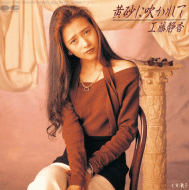Kōsa ni Fukarete
"Kōsa ni Fukarete" (
| "Kōsa ni Fukarete" | ||||
|---|---|---|---|---|
 | ||||
| Single by Shizuka Kudo | ||||
| Released | September 6, 1989 | |||
| Genre | ||||
| Length | 3:30 | |||
| Label | Pony Canyon | |||
| Songwriter(s) | ||||
| Producer(s) |
| |||
| Shizuka Kudo singles chronology | ||||
| ||||
| Audio sample | ||||
"Kōsa ni Fukarete"
| ||||
"Kōsa ni Fukarete" was the last song to top the charts of the TBS music show The Best Ten on its final broadcast on September 28, 1989.[1] At the 4th Japan Gold Disc Awards, "Kōsa ni Fukarete" was one of the five recipients of the award for Best Single of the Year, which Kudo also won that same year for her single "Arashi no Sugao".[2]
In 2015, DAM asked their users to select their favorite Shizuka Kudo songs to sing karaoke to and compiled a top ten list; "Kōsa ni Fukarete" came in at number one.[3]
Background and composition
"Kōsa ni Fukarete" marks the first collaboration between Kudo and Nakajima since "Mugon... Iroppoi".[1] The song was written by Miyuki Nakajima and Tsugutoshi Gotō.[4] Gotō composed the melody and produced the track before sending it to Nakajima, who then wrote the lyrics.[1] Lyrically, Nakajima employs an exotic imagery of Arabian sandstorms to convey the sentiment of feeling lost after a breakup.[5] She describes the perspective of a woman abandoned by her lover who finds comfort in the fact that there are "as many kind men as there are grains of sand".[5]
Critical reception
The song has been praised as being a "relatable anthem" to entire generations, present and future, of heartbroken women, who are also as "numerous as grains of sand".[5]
Cover versions
In 1989, Nakajima recorded a cover for her third self-cover album, Kaikinetsu. Nakajima's version contains slight changes to the lyrics and is also lowered by two whole steps. Kudo has performed the Kaikinetsu version on the Fuji TV music show Music Fair. In 2015, Kudo performed the song on the same program with Leo Ieiri, Trustrick and Mariya Nishiuchi.[6] In 1993, Krisdayanti recorded a cover of the song in English, dubbed "Lost in the Storm", which was included on the compilation album The Best of Asia Bagus. In 2013, Japanese model and singer Yūki Akimoto recorded a cover for Tsugutoshi Gotō's concept album, King of Pops.[7]
Chart performance
"Kōsa ni Fukarete" debuted at number-one on the Oricon Singles Chart, with 143,000 units sold in its first week, and topped the chart for six consecutive weeks, becoming Kudo's longest-running number-one single.[1][8][9] It logged a total of 22 weeks in the top 100 and sold over 500,000 copies.[10] The song was recognized by Oricon as the best-selling single for September and October 1989.[11][12] The single ranked at number nine on the year-end Oricon Singles Chart for 1989, and was one of three singles released by Kudo that year to rank in the yearly top ten.[13]
Track listing
All lyrics are written by Miyuki Nakajima; all music is composed by Tsugutoshi Gotō.
| No. | Title | Arranger(s) | Length |
|---|---|---|---|
| 1. | "Kōsa ni Fukarete" (黄砂に吹かれて, "Blowing in the Golden Sands") | 3:51 | |
| 2. | "Akiko" ( |
| 3:54 |
| Total length: | 7:45 | ||
Charts
| Chart (1989) | Peak position |
|---|---|
| Japan Weekly Singles (Oricon)[14] | 1 |
| Japan Monthly Singles (Oricon)[11] | 1 |
| Japan Yearly Singles (Oricon)[13] | 9 |
Certification
| Region | Certification | Certified units/sales |
|---|---|---|
| Japan (RIAJ)[15] | Platinum | 586,000[16] |
|
*sales figures based on certification alone | ||
See also
References
- "【1989年9月】黄砂に吹かれて/中高年に人気 工藤静香「ザ・ベストテン」最後の1位曲". Sports Nippon. September 20, 2011. Retrieved December 15, 2017.
- "第4回日本ゴールドディスク大賞 / Gold Disc Hall of Fame 3rd". Retrieved December 15, 2017.
- "カラオケで歌いたい工藤静香BEST10が発表!". Livedoor. December 1, 2015. Retrieved December 15, 2017.
- "工藤静香、22年ぶり黄金コラボ復活 中島みゆき&後藤次利と再タッグ". Oricon. December 23, 2014. Retrieved December 13, 2017.
- "工藤静香こそ"女心"の代弁者だった! 女たちが聞くべき世代を超える「アンセム」3選". Cyzo Woman. March 20, 2015. Retrieved December 15, 2017.
- "「Mフェア」に工藤静香、家入レオ、TRUSTRICK、西内まりや". Natalie. February 6, 2015. Retrieved December 15, 2017.
- "King Of Pops Guitar☆Man GPK". Oricon. Retrieved December 19, 2017.
- "工藤静香、「慟哭」以来22年ぶり中島みゆき&後藤次利コンビの新曲を発表". Real Sound. December 23, 2014. Retrieved December 15, 2017.
- "1989年9月18日付 CDシングル/アルバムランキング". Retrieved December 15, 2017.
- "工藤静香が"うしろ髪ひかれ隊"の曲含む10曲メドレー披露、吉田豪からの質問でたじたじに!? 「SONGS」". Entame Week. September 14, 2017. Retrieved December 15, 2017.
- "オリコン(oricon)「1989年09月」の月間シングルCDランキング". Retrieved January 18, 2018.
- "オリコン(oricon)「1989年10月」の月間シングルCDランキング". Retrieved January 18, 2018.
- "オリコン 1989年TOP100". Archived from the original on November 15, 2017. Retrieved December 15, 2017.
- "黄砂に吹かれて 工藤静香". Oricon. Retrieved December 15, 2017.
- ゴールドディスク認定 [Gold Disc Certifications] (in Japanese). Recording Industry Association of Japan. October 1989. Retrieved December 18, 2017.
Select 1989年10月 on the drop-down menu
- "音楽を語ろう特集『中島みゆきが詞・曲を提供!工藤静香の名曲を語ろう』". Oricon. Archived from the original on August 23, 2008. Retrieved December 15, 2017.